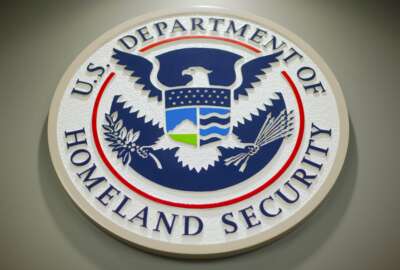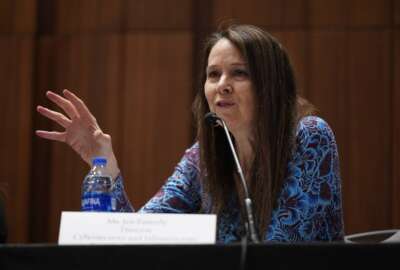
DHS CIOs see ‘IT academy’ as way to boost growing tech workforce
Like many agencies, DHS is trying to recruit new tech talent. But the agency also wants to advance professional development opportunities for its existing IT...
Department of Homeland Security officials say a new “DHS IT academy” will bolster their existing workforce’s technology skills and quickly train new hires who are entering the fray to help the department modernize its legacy IT systems.
The plan to establish the academy was highlighted during a Senate hearing this week focused on the challenges DHS faces in taking its $10 billion-a-year IT budget and maintaining critical legacy systems while transitioning to more modern applications.
DHS Chief Information Officer Eric Hysen described how the department has shifted away from “Big Bang” programs run by contractors. Instead, DHS will serve as the lead integrator for any modernization efforts going forward.
DHS has already revised plans, or is in the process of doing so, for several high-profile programs that have faced challenges, forcing the department to maintain legacy systems for longer than anticipated.
But in order to carry out its vision, DHS will need a skilled and specialized IT workforce to, as the cliché goes, fly the airplane while they’re building a new one.
Sen. Jacky Rosen (D-Nev.), a former computer programmer who coded in the legacy “COBOL” language in the 1980s and ‘90s, hit on that challenge during the Wednesday hearing held by the Committee on Homeland Security and Governmental Affairs emerging threats subcommittee
“You’re trying to find a workforce that can maintain [legacy IT] while you still have it, that can develop new systems, and then unload and reload, make that transition,” Rosen said. “We have to train the younger generation coming out on how to do those things.”
Hysen said the department is “largely free” of COBOL systems today. But with a significant amount of legacy technology remaining at DHS, he acknowledged an IT specialist joining the department will have a “different experience than working in the private sector.”
Hysen said CIOs across DHS components have agreed on a plan to establish a “department-wide IT academy” to help train new hires, but also provide professional development and rotational opportunities for its existing workforce.
As Hysen describes it, the IT academy could help address other workforce challenges beyond introducing fresh-out-of-college hires to the wonders of mainframe computing.
“That will include standardized training for all new IT hires into the department, as well as ongoing development opportunities for our employees to develop new skills, whether that be an AI and data science, customer experience, agile development, or the like,” he said.
While many rightly focus on the low pay in government compared to the private sector, studies from the National Academy of Public Administration and the Cyberspace Solarium Commission 2.0, respectively, have also identified the lack of professional development opportunities as another major problem for federal agencies in recruiting and retaining talented tech employees.
Chris Cummiskey, a former senior DHS official, said the DHS IT academy could help provide IT specialists with the same kind of training and development opportunities that are available to other career tracks.
“Standardizing technical orientation, providing ongoing training and opportunities to rotate to other component IT shops at DHS would create an important community of interest that exists in other lines of business like financial and procurement,” Cummiskey said.
Fostering a strong community within its existing IT workforce may be especially crucial as government hiring initiatives like DHS’s Cyber Talent Management System have been slow to get off the ground. DHS launched CTMS in late 2021 and initially aimed to hire 150 people within the first year using the streamlined hiring system that could offer higher salaries than traditional government pay rates.
DHS fell short of that goal, but CTMS is slowly gaining traction. DHS’s office of the CIO and the Cybersecurity and Infrastructure Security Agency have now hired more than 100 people using the system. And the Federal Emergency Management Agency is gaining the authority to use CTMS later this year, according to testimony from Wednesday’s hearing.
Similarly, DHS launched an ambitious “customer experience” hiring initiative in September 2022 aimed at hiring technologists with CX skills like product management and human-centered design. At the time, DHS said it aimed to hire “hundreds” of CX specialists.
So far, however, the initiative has brought onboard 25 new employees.
“It is a challenging time for DHS and other agencies in hiring quality IT professionals,” Cummiskey said. “Not only do they have to compete among government entities, there is also a strong demand in the private sector for these workers.”
Plans are in motion to further bolster agencies’ IT workforce. The Office of Personnel Management has approved a new Special Salary Rate for federal employees working in IT- and cybersecurity-related positions. And the White House’s Office of the National Cyber Director is developing a cyber workforce strategy aimed at increasing technology talent across the public and private sectors.
But DHS’s experience with CTMS shows it takes time for new recruiting processes to take hold in the federal government, making retention and professional development efforts even more crucial in the months and years ahead.
“The IT workforce at DHS is a tremendous asset,” Hysen said during Wednesday’s hearing. “We have over 5,000 talented and committed professionals. And so while we’re also looking to bring in more talent from the private sector, we have opportunities and are focused on enabling our existing workforce to grow and continue to increase their impact.”
Copyright © 2025 Federal News Network. All rights reserved. This website is not intended for users located within the European Economic Area.
Follow @jdoubledayWFED





